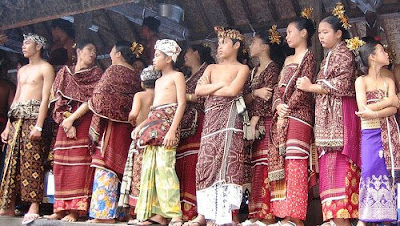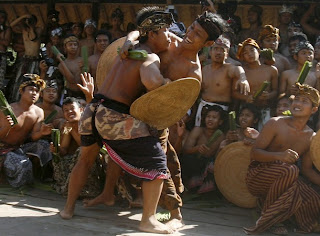 The village of Tenganan in Bali carefully preserves a cultural legacy dating back to the Majapahit Empire, and offers a unique glimpse into the lives of the first Balinese.
The village of Tenganan in Bali carefully preserves a cultural legacy dating back to the Majapahit Empire, and offers a unique glimpse into the lives of the first Balinese.Midway through each year, an undercurrent of intense excitement surrounds the unique Baliese village of Tenganan. A buffalo is ceremoniously slaughtered, while beautiful textile heirlooms are displayed in the open. An ancient wooden ferris wheels is specially constructed. And, perhaps most ominously, strips of thorny pandanese leaves are piled up, ready for the combat to begin.
All the action is in preparation for the village’s fifth-month celebrations. For hundreds of years, Tenganan has maintained its cultural authenticity through daily, weekly and monthly ritual and ceremony according to strict customary law. For the visitor, a visit to one of Bali’s most pristine villages is a glimpse of Bali as it once was – a time capsule preserving the lives of the original Balinese.
Tenganan is a walled communal village that has preserved its animistic cultural practices for hundreds of years. The village lies at the head of a narrow valley at the base of Bali’s sacred Mount Agung, about 3km into the hills from the eastern coastal holiday resort of Candi Dasa.
Locals call the Tenganese Bali Aga, or Bali Mula, meaning original Balinese. As such, their culture predates the Majapahit Empire (1294 to 1478) from which most mainstream Balinese claim cultural and spiritual descent. The 300 or so members of Tenganan communally own land that spreads far beyond the surrounding hills. They are reputed to be among the riches tribes on Bali.
You might not think Tenganan was so wealthy and socially complex at first sight. In this non-descript walled village, there are no streets or cars, merely two rows of houses doubling as shops, which face each other across an ancient village green.
Magical cloth
Tenganan is best known for its traditional cloth, called Kamben Gringsing, which transpates as both “flaming cloths” and “against sicknesses”. This peculiar double-ikat cloth – only woven elsewhere in Patola, India and Guatemala, Central America – is characterized by its distinctive colors. A group of four gringsing cloths takes up to eight years, and each piece can fetch as much as Rp 32 million (US$3,494). However, certain gringsing heirlooms are not for sale.
 An element of mystique surrounds gringsing. In the 1930s, Miquel Covarrubias wrote in Island of Bali that kamben gringsing was once dyed in sacrificial human blood and possessed magical powers. In turn, the wearer was said to be protected from black magic. Many mainstream Balinese still avoid Tenganan today, fearing black magic.
An element of mystique surrounds gringsing. In the 1930s, Miquel Covarrubias wrote in Island of Bali that kamben gringsing was once dyed in sacrificial human blood and possessed magical powers. In turn, the wearer was said to be protected from black magic. Many mainstream Balinese still avoid Tenganan today, fearing black magic.Clearly defined social structures forbid outsides marrying into the Tenganan community. Until 1925, marriage in Tenganan was only permitted within the village. Upon relaxation of this law, a village man could marry a single woman from one of the mainstream Balinese high castes without losing his right to live in the village. A villager breaking any of Tenganan’s laws is considered to be breaking divine law. The result is banishment for life to the outer village, to become a member of the organization of the fallen.
More than any other village in Bali, Tenganan performs rituals on a daily basis, to guarantee the spiritual purity and balance of the entire community. The most popular by far and highlight of the fifth Tenganan month is the thrilling mekare-kare (shiled) pandanas fighting.
Battle for blood
On the second day of the Usaba Sambah even from June 13 to 15 each year, Tenganan’s excitement reaches an electric and infectious climax. The atmosphere is tense as hundreds of local and foreign visitors armed with cameras edge forwards. Each strains to witness open combat, Tenganan style – combat between pairs of male villagers, boys and men alike, each armed with rattan shields and strips of thorny pandanas leaf.
Steadily, the rhythmic melody of the ancient gamelan orchestra builds, together with shouts of encouragement, as one combatant after another drinks rice wine, or tuak, before pairing off for battle.

Thwak! Thwak!
This is no play fight. Males of all ages participate in mekare-kare combat – and the aim is to draw blood. When bleeding does occur, fighting is supposed to cease. But sometimes the head and fervor of the moment gain the upper hand, forcing elders to step in to separate combatants.
The fight’s main skill is in attacking and dodging. Attacking is done by scratching or hooking parts of the opponent’s body with strips of thorny pandanus leaf. Anything between the neck and the waist is considered fair game. By and large, most scratches occur on the back.
Remarkably, the fight’s rules demand blood. Fights averaging two-to-three minutes may take longer, because the referee won’t stop the fight until blood is drawn. Afterwards, injured parties are treated with traditional medicine called bareh, which repairs the skin in a matter of days.
Maintaining harmony
Villagers see this bloodletting ritual with no winners or losers as a healthy reinforcement of masculinity. Village elder, I Putu Suarjana, says that according to Tenganan tradition, the blood-letting helps maintain a harmonious village: “When someone is fighting in the mekare-kare, anger will rise within him. However as soon as the fight is over this anger will vanish involuntarily.”
As the males assert their virility, young girls reinforce their culture ties too, observing the combatants while wearing gringsing, family heirlooms handed down by generations.
Aside from these public displays of cultural continuity, other key actions are take to safeguard Tenganan, including limiting the spread of capitalism. When concerns arose that the integrity of the village was being eroded as more houses were used as shops, the village council decreed these be restored to their original structure. I Nyoman Sadra, another village elder, explains: “Over the next few years, all our shops will have moved to the parking lot outside the front gate. But visitors will still be able to come into our homes where the old arts, including the making of gringsing are practiced.”
While acknowledging the outside world, Tenganan continues to draw its strength from its traditions. Parts of Bali may be radically transformed by tourism and change, but Tenganan village is intent on remaining an island unto itself.
